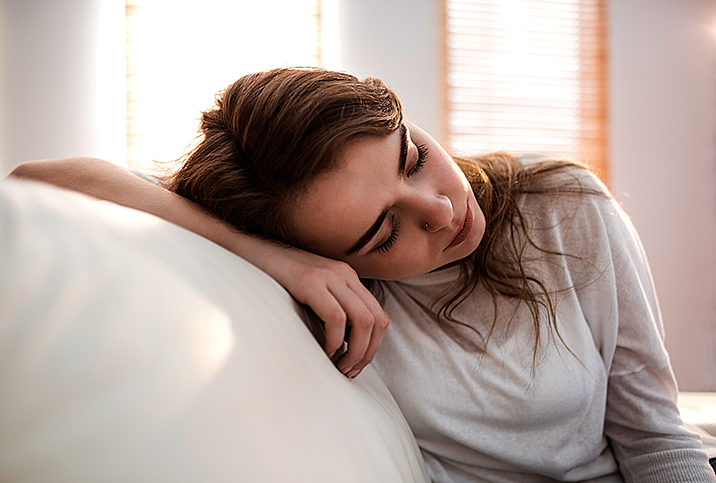Constantly Exhausted? It Might Just Be Iron Deficiency

For most of my life, I've felt exhausted.
I feel dizzy and lightheaded often, and feel sleepy during the day even if I've had a good night's sleep. I have heavy, painful periods that worsen my fatigue. If this sounds similar to your experience, you may have iron-deficiency anemia (IDA).
I was diagnosed with the condition when I was 18, after a blood test confirmed what doctors suspected. In conjunction with my few symptoms, there was the compounding fact that I don't eat red meat, which is a common source of iron.
I was prescribed an iron supplement, but years on, I still suffered from symptoms. In 2018, I was told I needed to get iron (ferrous) injections/IV infusions as I had virtually no iron stored in my body. My family physician relayed to me that iron deficiency is especially common among women in their 20s and 30s.
A look at iron deficiency
Get Iron Informed, a health initiative that encourages women to learn more about their iron levels, recently surveyed 1,000 women between the ages of 18 and 65. Among other findings, the survey discovered:
- Half of the women surveyed (51 percent) experienced an IDA symptom in the previous 12 months, but nearly a third (31 percent) said they hadn't discussed any of those symptoms with their doctor.
- Ninety percent of women said they pay close attention to changes in their body, but many (62 percent) only go to the doctor if they are experiencing severe symptoms.
- Women who didn't discuss their symptoms with a doctor most commonly said it was because they didn't think it was serious enough (32 percent) or attributed their symptoms to something else (30 percent), such as age, stress, diet, sleep or pregnancy.
- Less than half of the women surveyed (45 percent) have ever undergone iron panel testing and didn't know you needed to ask for it as part of their annual physical, as it's not automatically included in standard blood testing.
Nearly half of the women surveyed (45 percent) were unfamiliar with iron-deficiency anemia. The survey also revealed, on average, women with IDA experienced a delay in diagnosis of 3.9 years from the onset of symptoms.
Frequently dismissed as stress or exhaustion, IDA continues to be underdiagnosed. About 1 in 5 women of childbearing age have iron-deficiency anemia, a condition that can cause stress, brain fog, brittle nails and, occasionally, cravings to consume ice or dirt. Also, the elderly are at high risk for iron deficiency anemia.
Who is at risk for IDA?
Soma Mandal, M.D., a board-certified internist at Summit Health in Berkeley Heights, New Jersey, says women are most at risk for iron-deficiency anemia due to childbirth and menstruation.
"Women can have uterine fibroids or endometriosis, which can cause heavy bleeding and cause iron deficiency," Mandal said. Other reasons for IDA can include consuming too little iron in your diet, common for those with vegetarian or vegan diets, Mandal added.
Amy Revene, MBBS, is a family practitioner at New Hope Medical Center in Dubai and collaborating doctor with Scandinavian Biolabs. Like Mandal, she links iron-deficiency anemia to pregnancy.
"During pregnancy, iron-deficiency anemia can cause complications with the pregnancy and issues for the developing infant," Revene said. "People who are breastfeeding should also get tested for IDA."
However, it's not just reproductive issues that are affected by iron-deficiency anemia.
"Certain conditions that can cause malabsorption in the gut—celiac disease, intestinal surgery, gastric bypass—can cause iron deficiency as well, and people who donate blood frequently can experience iron deficiency," Mandal said. "Infants born prematurely or children experiencing a rapid growth spurt can also have iron deficiency."
Kim Langdon, M.D., an Ohio OB-GYN at Medzino, says female athletes are also at risk of developing IDA, as well as people with von Willebrand's disease and hemophilia, two genetic blood disorders.
In the long term, IDA can pose significant impacts on the body. Mild iron deficiency may not lead to significant health problems later in life. However, a rapid or irregular heartbeat can develop due to the heart needing to pump more blood to compensate for the deficiency of oxygen carried in your blood when you're anemic. This can cause an enlarged heart or heart failure. In children, IDA can lead to stunted growth and increased susceptibility to infection.
How IDA is diagnosed
Mandal says anyone at risk of developing iron-deficiency anemia should see their primary care physician and ask if their iron levels can be checked.
"In addition to a CBC (complete blood count), your doctor should check your ferritin, a blood protein that stores iron," Mandal said. "Low levels of ferritin show there is low iron storage. The doctor should also check your iron/TIBC. Total iron-binding capacity (TIBC) is used to determine the amount of transferrin (another protein) that is carrying iron."
Chandar Mohini, MBBS, M.Sc., is a family physician and hormone specialist at Primanora Medical Centre in Kuala Lumpur, Malaysia. She says IDA is often underdiagnosed—some doctors don't treat it as a serious condition and, subsequently, don't test for iron-deficiency anemia when conducting blood tests on patients.
"It is extremely important to be a self-advocate and ask your doctor to conduct a ferritin test, especially if you are a menstruating woman or a vegetarian," Mohini said.
Additional tests may be conducted to check for possible underlying causes for the iron deficiency. For example, doctors may conduct an endoscopy, a procedure that uses a camera attached to a tube inserted into your mouth, through the esophagus, down to the stomach. This allows physicians to check for bleeding.
Other tests include a colonoscopy, a test that uses a video camera attached to a tube inserted at the rectum and into the colon that allows the doctor to check for bleeding in the rectum and colon areas. Doctors may also perform a pelvic ultrasound to check for uterine fibroids, which can cause significant menstrual bleeding that can lead to IDA.
Treatment for iron-deficiency anemia
After being diagnosed with iron-deficiency anemia, the next step is to get treated for it.
"Treatments for iron deficiency include various forms of iron supplements: ferrous fumarate, ferrous sulfate, ferrous gluconate and polysaccharide iron complex," Mandal said. "If the iron deficiency is serious enough, you may need intravenous iron. Ferric carboxymaltose and iron sucrose are two examples."
Constipation while taking iron supplements is common. Adding fiber supplements can help you maintain regular bowel movements, Mohini said.
However, nutritionist Lisa Richards warns against certain dietary combinations.
"When it comes to taking an iron supplement, or a multivitamin that contains iron, it is important to avoid taking calcium or consuming calcium around the same time," Richards explained. "The term 'elemental iron' refers to the amount of iron absorbed from each capsule. There are two forms of iron—heme, from animal sources, and non-heme, from plant sources. Heme iron is absorbed at about 25 percent, while non-heme is absorbed at about 17 percent. Most iron supplements on the market are made from non-heme sources, which is great for vegan dieters but should be paired with a vitamin C source for better absorption. All iron supplements should be taken at least two hours pre- or post-meal to prevent the mineral from having to compete with other minerals for absorption, specifically calcium."
Megan Wong is a registered dietitian working with AlgaeCal, a company that provides free nutrition info, recipes and exercises for bone health. She says foods high in heme iron include meat, fish and poultry.
"Organ meats, like liver, are very high in iron, but if organ meats aren't your thing, oysters, beef and chicken are good choices for boosting your iron levels," Wong said.
For foods rich in non-heme iron, she recommends eating plant-based foods such as tofu, legumes, spinach, nut butters and oatmeal, combined with vitamin C sources.
"For example, combine black beans with bell peppers, have a spinach salad with strawberries and oranges or cook up a tofu stir-fry with broccoli," Wong added.
Mandal and Revene also recommend dried fruits, nuts, eggs, baked potatoes, tofu, whole-grain, enriched bread and iron-fortified cereals as excellent sources of iron.


















